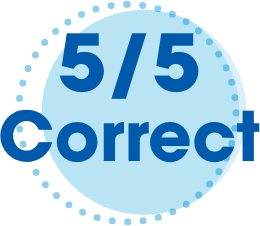TAKE THE FACTOR FLUENT QUIZ
WHAT IS HEMOPHILIA?
Hemophilia is a rare and serious disease caused by an imbalance of hemostasis where missing clotting factor proteins can prevent stable blood clot formation, leading to excessive bleeding. In people with hemophilia, bleeds can happen during everyday activities, such as at work or school.
THE IMPORTANCE OF FACTOR ACTIVITY LEVELS
Hemophilia severity is determined by “factor activity levels,” a measurement of how much factor you have in your blood at time of diagnosis. The more factor you have in your body over time, the better your bleed protection is, which is why many people with hemophilia choose to treat prophylactically. Your doctor can perform measurements to evaluate the factor activity levels in your blood.
According to the World Federation of Hemophilia (WFH) guidelines, the goal of prophylactic factor replacement therapy is to always keep your factor levels above 1%. However, factor levels of 1%–3% cannot prevent bleeds in all people with hemophilia.

Restoring hemostasis is essential for stable clot formation. The more factor you have in your body over time, the better your bleed protection is, which is why many people with hemophilia choose to treat prophylactically.
THE ADVANTAGE OF
HIGH FACTOR LEVELS:
When your factor levels stay above 40% (in the near-normal to normal non-hemophilia range), you may be able to engage in activities longer without having to worry about spontaneous bleeds, which is often a worry for those with hemophilia. The more time factor activity levels are above 40%, the better your outcomes may be. This is why many keep searching for treatments that improve bleed prevention, reduce treatment burden, and improve their quality of life.
The following chart shows how factor activity levels impact the lives of people with hemophilia.
People without hemophilia have factor levels above 40% and people with hemophilia have factor levels below 40%. The more time factor activity levels are above 40%, the better your outcomes may be. When levels drop below the non-hemophilia range, people with hemophilia are at an increased risk of bleeding, which impacts their lifestyle and outcomes.
Because there are differences between hemophilia A and B, treatment management and strategies
should be different too. Talk to your doctor about managing your hemophilia.
Click through the chart below to see how your factor activity levels (for Mild, Moderate, and Severe hemophilia) can correlate to potentially safe activities.
As the chart above illustrates, when factor levels are lower the bleed risk associated with physical activity may increase.
Learn more about how factor VIII and vWF work together and how factor IX travels in the body to better understand factor activity.
The Joint Movement
Since staying active may improve joint health, you can get help from The Joint Movement, a resource for people of all mobility levels that provides resources and inclusive community workshops that promote joint health. As always, talk to your healthcare provider before starting any physical activity.
THE PHARMACOKINETICS (PK) CURVE AND FACTOR ACTIVITY:
WHY IT MATTERS
Pharmacokinetics (PK) is a branch of science that studies how a medicine is absorbed, distributed, processed, and removed by the body. It’s used by doctors to evaluate factor activity levels in your body.
By evaluating your factor activity levels in blood samples taken at different times after an infusion, your doctor can calculate 6 key pharmacokinetic characteristics and better navigate treatment considerations.
THE PK CURVE
Click on the circles to learn more about the curve.PEAK
This is when factor activity levels are the highest in your body, just after an infusion.
THE 6 PK CHARACTERISTICS YOU SHOULD KNOW:
PEAK:
This is when factor activity levels are the highest in your body, just after an infusion.
AREA UNDER THE CURVE (AUC):
This represents how much factor you have in your body over time.
TROUGH:
This is when your factor activity levels are at their lowest, right before your next dose.
- In hemophilia A, trough levels provide a good estimate of bleed protection since factor VIII stays largely in the bloodstream.
- In hemophilia B, trough levels alone don’t accurately assess bleed protection since factor IX can leave the bloodstream.
CLEARANCE:
The speed at which factor is eliminated from the body.
VOLUME OF DISTRIBUTION:
A measure of how much factor is in the blood and in other tissues in the body.
HALF-LIFE:
This is how long it takes for factor to lose half its concentration after an infusion. The longer your factor’s half-life is, the longer it will stay in your body to protect you from bleeds.

Understanding these terms will help you better navigate your treatment options. Talk to your healthcare team to learn more about what pharmacokinetic characteristics should be considered as part of your treatment plan.
TAKE THE FACTOR FLUENT QUIZ
Test your hemophilia knowledge in this easy-to-follow quiz below:






Factor levels are always the same for everyone.
TREATMENT APPROACHES
Those with hemophilia generally choose between one of two treatment strategies:

ON-DEMAND (OR EPISODIC)
This means treating with factor replacement whenever you have a bleed.

PROPHYLACTIC (OR PREVENTATIVE)
Treatments are taken on a regular basis to restore missing or low factor levels, and in case of a bleed, promote clot formation.
MOST COMMON THERAPIES
There are various treatments for hemophilia that can use different mechanisms to provide protection from bleeds and restore hemostasis when an injury occurs.
FACTOR REPLACEMENT THERAPY
These involve infusions of the missing clotting factor to prevent or treat bleeding. Factor replacement therapy is a “monotherapy,” which means it can be used for prophylaxis, on-demand, and preoperative regimens, so you don’t need another product to provide bleed protection or to respond to a bleed.
NON-FACTOR THERAPIES
These aim to enhance clotting by mimicking the activity of clotting factors to provide ongoing, prophylactic bleed prevention. These are not approved for on-demand use because they’re not able to create clots to stop an active bleed.
You’ll need a separate on-demand factor replacement to treat a bleed or when preparing for surgery. Your doctor will discuss with you an appropriate treatment plan for bleeds and surgery if you are using a non-factor prophylactic treatment.

There’s still progress to be made in the treatment of hemophilia to improve bleed prevention and quality of life, while reducing treatment burden.
Talk to your doctor to learn more about your hemophilia treatment options.
GET COMMUNITY EDUCATION
If you’re looking for more info or resources, our dedicated team of Community Relations & Education (CoRe) managers is ready to connect one-on-one, anytime. They’re just a call or email away.
STAY INFORMED
Sign up to receive helpful information to address your hemophilia needs, such as disease education, treatment options, and other resources to help you make the best decisions for your goals.
MAT-US-2204625-v3.0-03/2023